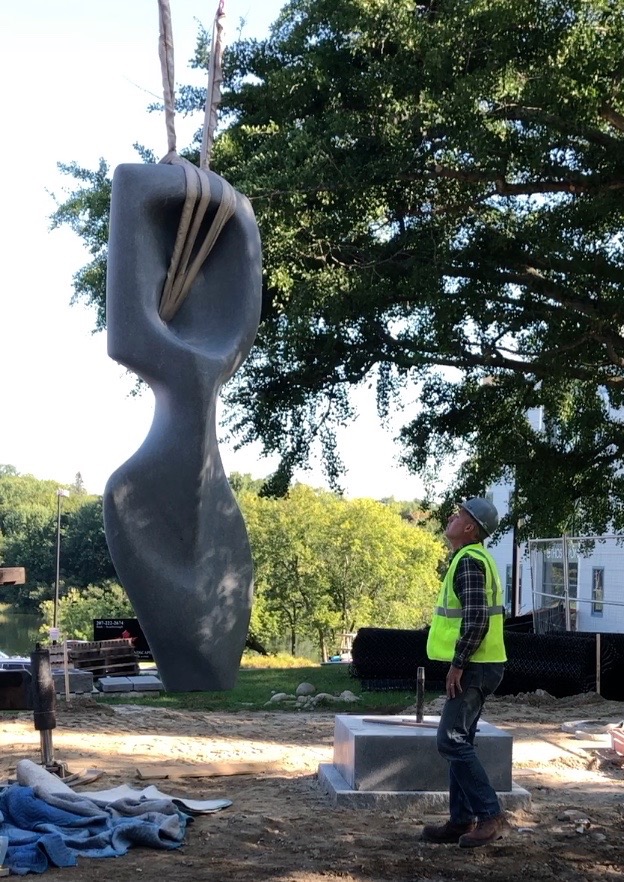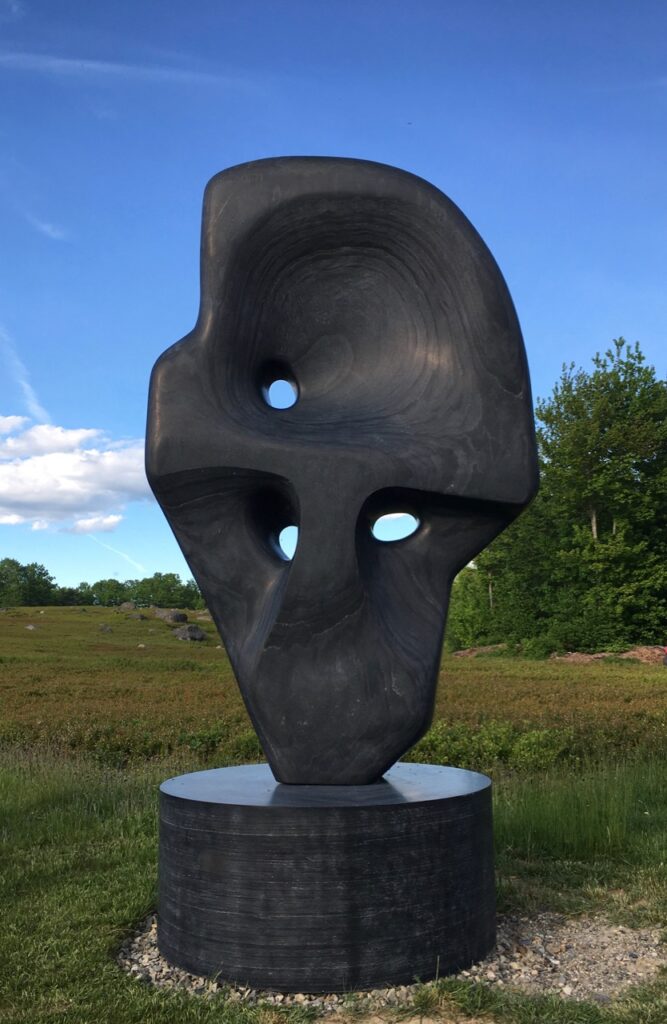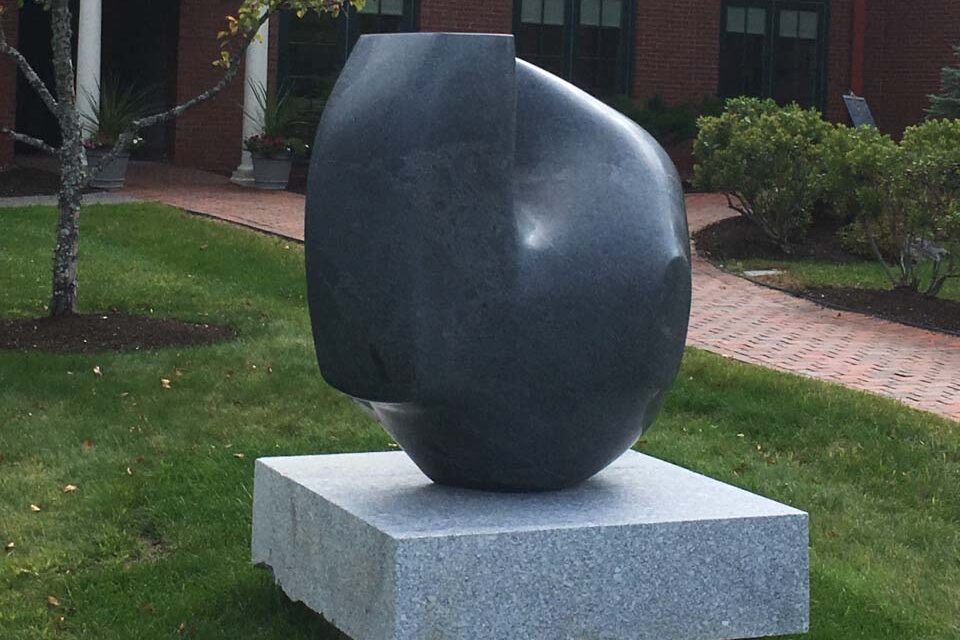Sculptures and other pieces of public art have the ability to redefine a space and represent entire communities. These sorts of transformations can occur at various levels and in different ways, but such distinctions are always the result of an idea or feeling that takes literal shape. Doing so at multiple scales is the focus of sculptor Hugh Lassen.
 Born in 1976 in Edinburgh, Scotland, Lassen learned to carve after seeing a small Native American spear weight carving in a museum. His approach to form is focused on providing a living expression of weight that also considers measure, balance, rhythm and harmony. This expression and balance can be seen in his large stone sculptures as well his smaller stone pieces.
Born in 1976 in Edinburgh, Scotland, Lassen learned to carve after seeing a small Native American spear weight carving in a museum. His approach to form is focused on providing a living expression of weight that also considers measure, balance, rhythm and harmony. This expression and balance can be seen in his large stone sculptures as well his smaller stone pieces.
Lassen’s public works include “Rhino,” at the entrance to University of Maine’s Buchanan Alumni House, and “Seed Form,” also located at the University. He’s working on a new commission for a site-specific location that is causing him to focus on how the public will interact with the piece. Too big and it won’t be approachable, but too small and it won’t be noticed. We talked with him to further explore this balance, how audiences have interacted with his sculptures, what it can mean for the public to embrace this sort of work and much more.
Jeremiah Karpowicz: When and how do you consider the surrounding elements and/or community for one of your pieces?
Hugh Lassen: I began studying stone carving in New York. My instructor told me, if I really wanted to be a sculptor, to put away my hammer and chisel and learn to draw. After many years studying the figure and sculpture at museums, I began to explore more directly in stone.
For practical reasons, I was working on a small scale and by hand and really I was just fascinated by sculptural form. As I got more confidant, I’ve begun to push scale and carve harder, more durable stones using power tools. A couple of these larger sculptures were sited temporarily near a library, for example, and were eventually purchased because they fit.
That kind of fit is something I wanted to ask you about because it seems to be an essential element when it comes to the type of public sculpture that you’re currently working on. Do you envision that one of your pieces could become a “signature” piece for a city or community?
Well, of course, that would be lovely but there is a big part of it that is out of your hands, as a sculptor. Your idea has to be before stakeholders who are willing to champion it and clear the path. After all this, your sculptural idea has to be vital enough to engage the public so it becomes adopted by folks who have no background in the arts. This is a tall order!
No doubt, which speaks to the balance that can be seen in various ways in your work. I imagine there’s a balance between how you envision the shape of a stone can be refined, just as there’s a balance between how much feedback you might incorporate from stakeholders or audiences? What are some of the main driving factors around how the forms of your large stone sculptures take shape?
I usually start with drawings and I try to match an idea to a piece of stone taking into consideration the texture, grain and color of the stone. As I carve the sculpture the initial idea is refined and clarified.
The large pieces are an adventure; a mountain to climb. The logistics around flipping and moving the larger stones increase, the time invested in the piece increases, and it’s easy to lose heart. At the same time there is excitement in realizing a new idea. The feedback from folks comes later and it’s not always easy to hear but we, as sculptors, need to hear it!
 What are some of the ways you’ve seen or heard about audiences engaging with pieces like “Seed Form” or “Figure”?
What are some of the ways you’ve seen or heard about audiences engaging with pieces like “Seed Form” or “Figure”?
Some children put their arms through “Seed Form” like that game where one child stands behind another and pretends the other child has four arms. Children immediately jump to the tactile response to sculpture – it is wonderful.
In some ways, I feel like they enjoy my sculpture better than adults that immediately wonder, “What does he mean by that title?” Or “How much does this cost?” etc. etc. For me, sculpture is all about refining your feelings around a certain ponderable idea.
Do you believe the permanence of your pieces resonates with audiences? How important is that factor to you?
Permanence can be a double-edged sword. I have plenty of lesser ideas stuck in my yard!
The sculpture I admire most seems to be carved from stone so that is where I find myself. I like the mass, weight, heft of stone and it’s also a slow process so you’re forced to refine and refine. I do think that audiences are very open to stonework once they experience it. In a way, you have brought your idea to the best point you can and there it sits… it is not rotting or withering.
Making permanent sculptures could be seen as an ego trip but I’m aware that not all of my work deserves to be made in a permanent material, however, I never know which ones when I start!
What are some of the most powerful or memorable pieces of feedback you’ve gotten about how one of your pieces has impacted stakeholders, viewers or entire communities?
It is very humbling to site a sculpture in public. You can see all of the flaws of your piece whilst around you people seem excited or perhaps indifferent. You throw your pebble in the pool and hope the waves bounce back from the farthest shore.
Last year a young man and his wife came to visit the Littlefield Gallery where I show my work. They were literally touching the stones. The young man was quiet and withdrawn. Four days later his wife came back to the gallery and told Jane and Kelly Littlefield that her husband had died of cancer. They had driven by the gallery many times before but had never gone in until that day. There was something soothing about the sculptures.
To learn more about sculptor Hugh Lassen, visit his site.
